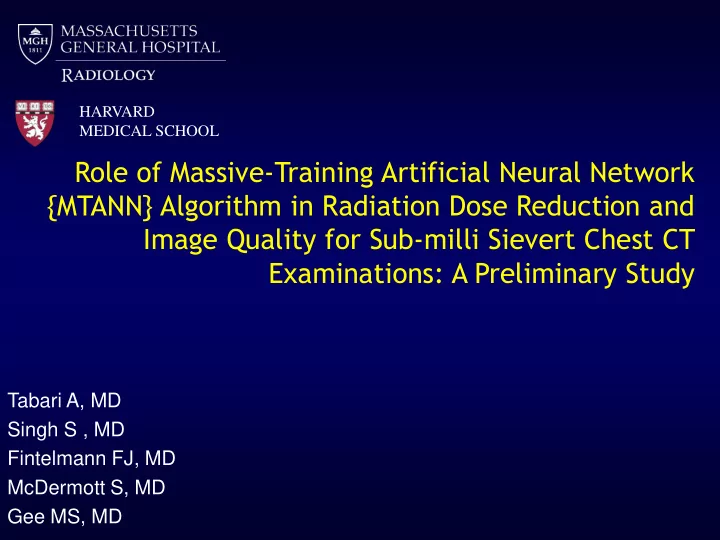

HARVARD MEDICAL SCHOOL Role of Massive-Training Artificial Neural Network {MTANN} Algorithm in Radiation Dose Reduction and Image Quality for Sub-milli Sievert Chest CT Examinations: A Preliminary Study Tabari A, MD Singh S , MD Fintelmann FJ, MD McDermott S, MD Gee MS, MD
Financial Disclosure None of the authors had any financial relationship pertinent to the study Ethical Committee Approval • The study was approved by the IRB and was compliant with HIPAA guidelines
Background Decrease in radiation dose Image processing No Image processing Algorithm Increased image noise Constant / less increased noise versus versus standard dose standard dose Acceptable Diagnostic Lowered Diagnostic Confidence Confidence
rning Pi PixelSh elShine ine - De Deep ep Lea earning • Can map any complex “ functions” function noisy clean
Pi Pixel elShi Shine ne - Deep p Lear arni ning ng • Learns from training examples noisy clean
Pi Pixel elShi Shine ne - Deep p Lear arni ning ng • A lot of computation for training Adjust weights by repeated training
Pi Pixel elShi Shine ne - Deep p Lear arni ning ng Once training is done, – Process images using fixed weights – Processing is fast* *Processing time: about 8 slices / sec
Pi Pixel elShi Shine ne - Deep p Lear arni ning ng • Processes reconstructed images • Is CT vendor & recon algorithm agnostic
PURPOSE To evaluate Massive-Training artificial neural network {Pixelshine} algorithm and Filter Back Projection (FBP) reconstruction techniques for 27% radiation dose reduction and image quality for chest CT
Materials and Methods • In an IRB approved and HIPAA study, 13 patients (mean age 63.9 ± 11 years, M:F 9:4, weight 174.8 • ± 38 lbs) • underwent “routine” chest CT with standard and low dose. • Patients were scanned on • 128 slice MDCT SOMATOM Definition Flash • Discovery 750HD
Materials and Methods • All scanning parameters, except tube current, were held constant including – 120 kVp – 0.984:1 pitch – 39.37 mm table speed per gantry rotation – 0.5 second gantry rotation time – Detail reconstruction kernel-CT chest
Materials and Methods • Detailed CT image quality, including • objective image noise, • Hounsfield Unit values and • contrast to noise ratio (CNR) • were measured in • thoracic aorta, • pectoral muscles, • para-spinal muscles, • air outside the thoracic cavity. • Standard dose images were considered as the reference standard for image quality and statistical analyses were performed using the t-test
Materials and Methods • Radiation dose parameters, including • CTDIvol, • Dose Length Product and • estimated effective dose was calculated as per ICRP103.
Results – Standard and low dose chest CT examinations were performed for clinical indications, including – metastasis evaluation, – pneumonia, – pulmonary obstructive disease. • Low dose chest CT images were acquired at 81% {CTDIvol 9.1 ± 6/1.8 ± 0.2 mGy} lower dose. – DLP was 66 ± 2 mGy.cm and 322.7 ± 217 mGy.cm, – effective dose 1 mSv and 4.8 ± 3.3 mSv, for low and standard dose, respectively. –
Results Image noise was significantly decreased by 27% {62.3 ± 19/ 84.1 ± 28} in low • dose Pixelshine images as compared to low dose FBP{p <0.004}. HU values were similar in low dose Pixelshine (27.5 ± 23) as compared to standard • dose (39.2 ± 10) (p> 0.1). • CNR was significantly improved in Pixelshine compared to standard dose FBP images {p<0.002}
Pi Pixel elShi Shine ne Lung Study dy 1 SIEMENS 100kVp 50mAs 1mm B60f SIEMENS 100kVp 50mAs 1mm B60f FBP FBP + PixelShine
Pi Pixel elShi Shine ne Lung Study dy 2 SIEMENS 100kVp 26.3mAs 1mm B60f SIEMENS 100kVp 26.3mAs 1mm B60f FBP + PixelShine FBP
Pixel elSh Shine ine Lung Study dy 3 SIEMENS 100kVp 12.1mAs 1mm B60f SIEMENS 100kVp 12.1mAs 1mm B60f FBP FBP + PixelShine
Pi Pixel elShi Shine ne Lung Study dy 4 TOSHIBA 120kVp 5mAs 0.5mm FC05 TOSHIBA 120kVp 5mAs 0.5mm FC05 FBP FBP + PixelShine
Pi Pixel elShi Shine ne Lung Study dy 5 TOSHIBA 120kVp 5mAs 0.5mm FC05 TOSHIBA 120kVp 5mAs 0.5mm FC05 FBP FBP + PixelShine
Conclusion • Pixelshine algorithm reconstructed CT images lowers noise by 27% in 81% low dose images {1.8 mGy} compared to conventional FBP • Low dose chest CT acquired at 1.8 mGy is feasible with Pixelshine algorithm
Thank You
Recommend
More recommend